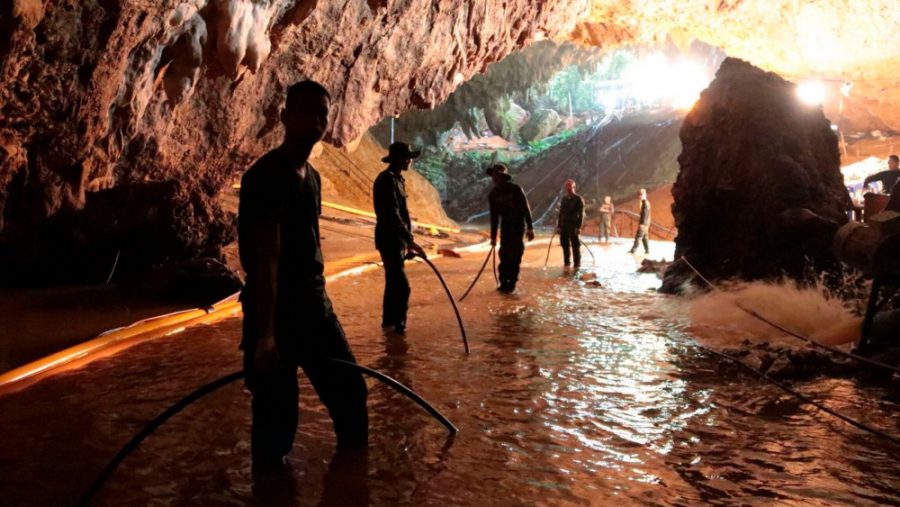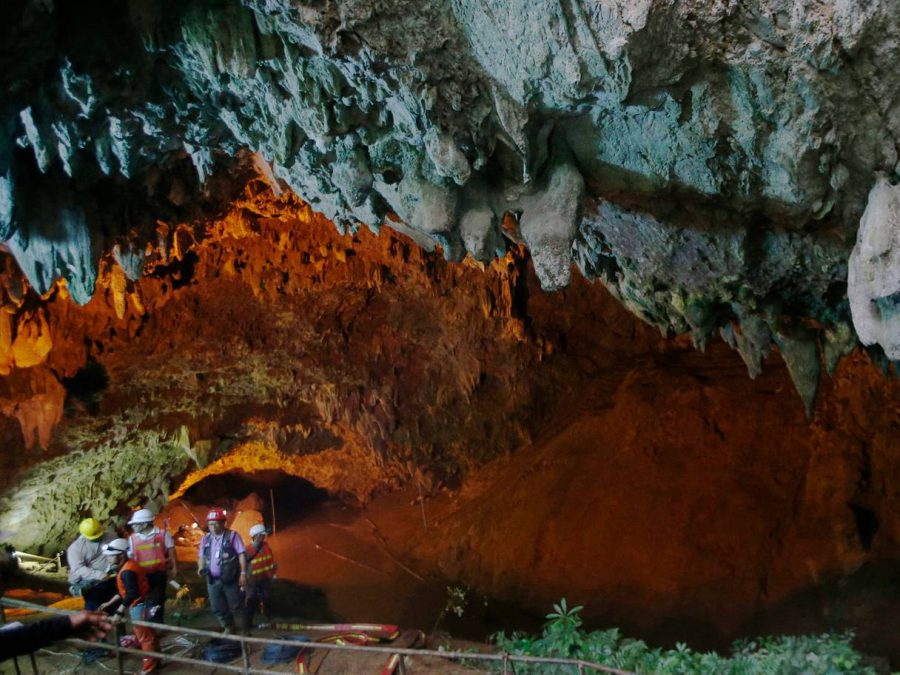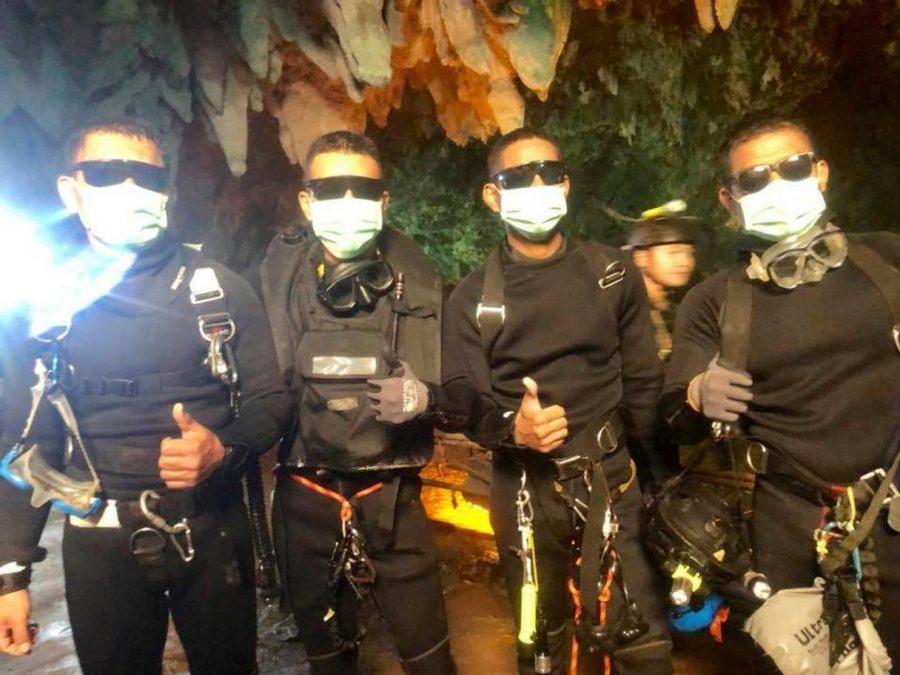In a cave, the dangers take all forms
A cave expert explains the many difficulties faced by the trapped Thai soccer team and the divers who saved them
Raider Times photo / Courtesy Reuters
The 12 members of the Wild Boars soccer team and their coach arrive for a news conference in Chiang Rai, Thailand.
July 21, 2018
On June 23, 12 boys, part of the Wild Boars soccer team, and their coach entered into the Tham Luang cave in Thailand. The team entered under the impression of a quick one-hour exploration before heading back to a birthday party.
Little did they know that the next time they would see another person would be nine days later and the next time they all would see daylight, their families and friends, would not be until July 10 because of how the cave had flooded.
What happened during these two weeks, and what different things did the boys have to battle inside the cave? Ender Usuloglu, a member of the Boston Grotto, a caving organization, gave me some insight.

In this undated photo released by Royal Thai Navy, Thai rescue teams arrange water pumping system at the entrance to a flooded cave complex where 12 boys and their soccer coach were trapped.
He started off explaining that there are two types of caves, fossil and sinkhole caves. The difference between the two is that fossil caves are not active, meaning there is not water rushing into it. Therefore, it should be OK to go inside year-round, even if it is raining.
Sinkhole caves drain water from the surface and are not safe to travel in during their wet season. It also depends on whether the cave is horizontal, because, even if there is just a small river, horizontal caves are dangerous since they can flood at any time.
If a cave does flood, the best thing to do would be to seek higher and dryer ground, even unfortunately if that means going deeper into the cave. It is much more dangerous to go against and into the water. Fortunately for the Wild Boars, that is exactly what they did. Another good thing they did was that they stayed in one place and did not try to escape. Most of the boys didn’t even know how to swim, which, in the end, worked in their favor.
Usuloglu explained that there are three zones in a cave. First, there is the entrance where there is full sunlight. After, the light gets dimmer with half-sunlight and half-darkness, and finally complete darkness. To explain how dark it is in the third zone, Usuloglu said, “For example, If I put my finger in front of my face, I will not be able to see it.”
For the nine days, the boys were alone and this is what they experienced as well. After a number of days in this darkness humans are susceptible to losing their concept of time and what might seem like three hours might really be eight. Inside the cave might feel like forever, especially if you don’t know if you will be rescued. Add this to the feeling of not knowing if you will ever see your family again, and this can put you in a state of panic and can even lead to mental problems.
One thing that the Thai boys did have was each other, as well as their coach, Ekkapol Ake Chantawong, a former buddhist monk who taught them how to relax and meditate. This type of thinking helped the physiological problems that can be formed if someone stays alone or without food for a long period of time.
There was also the problem of the temperature inside the cave. Although the team found a little shelf that was dry, the water made the cave colder and so did the air currents and high altitude. In fact, even if the cave was warm and humid in the first place, if people were to stay in the water they could get very cold and maybe even experience hypothermia.
But, the most dangerous condition was one that might not have been present at first, but later was what prompted Thai officials to decide to quickly launch the rescue operation. When I asked Usuloglu about the oxygen levels in caves he responded with, “I’ve been caving for 31 years now, I’ve come across only one time that there was a lack of oxygen in one cave, and it was because there was carbon dioxide culminated in one place and we had trouble breathing.”
Normally a cave is open to the air and there might also be a small stream or something of the sort where the water will carry oxygen into the cave. He added that it will only become a problem when one is trapped and it is flooded and every available hole is plugged. For the boys, this was a big issue because there was only a certain amount of oxygen. Every time they inhaled and exhaled, the carbon dioxide in the air would increase. Oxygen levels normally are 21 percent, but soon levels fell dangerously low to 15 percent. This can cause one to hallucinate, it affects judgement and coordination, as well as breathing. Oxygen levels less than 6 percent result in someone eventually passing out and dying.

A rescue team stands in the entrance to the cave.
Luckily, the boys were extracted before oxygen levels could get worse. But, a dangerous effect of dropping oxygen is panic and one will hyperventilate, only making the situation worse. The trick Usuloglu told me is to slowly breathe and to also not take as many breaths as one normally would. During these nine days, the boys also lost a lot of energy and body composition due to the lack of food, so they became pretty weak.
But darkness, carbon dioxide, and the cold are not the only difficulties that confronted the 13. Inside the caves a variety of small animals also reside. Included are bats, insects, and cave salamanders. Creatures living in the dark space for a long time tend to lose some senses like sight and gain others, like hearing. These are called troglobites and they’re mostly endemic, meaning they cannot leave the cave without dying since they are very particular to that environment.
Although most of these animals are not harmful to humans, there are also some microbiologic animals which can be. Bacteria and fungus are microscopic, so they are not visible to the human eye, but are still just as harmful. Usuloglu explained to me is a type of bacteria that develops on the feces of bats and is very dangerous. This bacteria should not be inhaled or else you could get sick and die. He advises cave explorers to stay away from guano, which is the accumulated excrement of bats and to wear gloves and a bandage over the mouth. But the 12 Thai boys and their coach were vulnerable to this danger.
On July 2, after days of divers exploring the cave, all 13 members of the Wild Boars were found. British divers John Volanthen and Rick Stanton made the discovery and the boys were soon joined by a military medic, as well as Navy SEAL divers. These divers brought them food, blankets, and light. During this time rescuers were still contemplating how to extract the 13. Plans of pumping out the water and possibly drilling from above would take time and as oxygen levels dropped, authorities realized they were in a race against time. This meant they would have to go with the most dangerous option considered for the team, which was to help them partner-dive out of the cave.
Rescuers had been diving roughly six hours to and from the boys and many were professional cave divers who had volunteered from around the world. The boys still weak, were practicing using oxygen tanks and other diving equipment. On July 8 when the rain took a break, the strongest four, accompanied by divers, left their ledge. Before embarking on the treacherous journey, the boys were given anti-anxiety medication as to not panic on the dive.

The last four Thai Navy SEALs come out safely after completing the rescue mission inside a cave where 12 boys and their soccer coach were trapped.
Even for the most experienced divers, cave diving is very difficult because of its differences from open-water diving. Like it says in the name, in open-water diving if there is trouble or difficulty one way or another a diver can go up to the surface, whereas during cave diving a person cannot and is surrounded by very narrow, winding passageways. Another strain is the fact that in a cave of different altitudes, instead of just breathing pumped air, a person will breathe a mix of gasses because the air pressure is different.
One last obstacle Usuloglu mentioned the divers might have been faced with was the common occurrence of a silt out. A silt out happens when the mud/dust on the floor is hit with a fin, and the whole water around the diver becomes muddy, resulting in the diver not being able to see the surroundings. This is very dangerous and so, while cave-diving, it is important that each diver holds onto a rope that goes through the opening of the cave and that they don’t let go.
There were also many narrow places where the divers and boys had to take the oxygen tanks off their backs, which just added to the complication, but once divers made it to Chamber 3, it was time for Phase 2, which consisted of each boy being put in a stretcher and using a pulley system, while a team of five rescuers, carried the boy.
This whole procedure took three days, as kids were taken out in fours. On the last day, the coach accompanied the final four. Divers needed time to rest and replenish air tanks, and this gave the remaining team members time to get stronger.
By the last day of rescue, water levels were rising again and even though the whole team was out, many divers and medics were still inside. As soon as these last people left the cave, one of the pumps immediately stopped working, and soon the whole cave was flooded.
The boys and their coach were taken to a hospital in Chiang Rai and were given health checks. Some of the team had lung and eye infections, so they needed antibiotics. But, apart from that, the team escaped the dangers they were exposed to in the cave.
— July 20, 2018–




















Renin Tarman On • Jul 21, 2018 at 3:34 pm
This is a very informative article for me, congratulations Leyla
Mike Mandel • Jul 21, 2018 at 12:43 pm
A great in depth article that provides greater insight into the issues of caving.